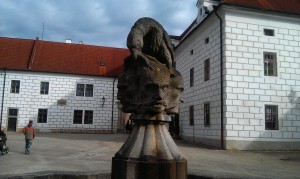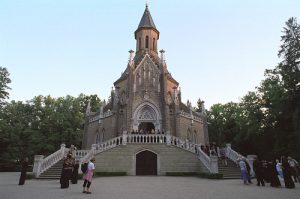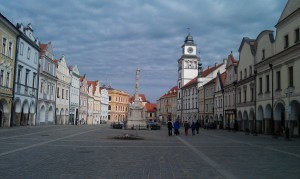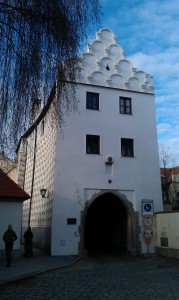Třeboň: an architectural gem in southern Bohemia
By Tracy A. Burns
To call southern Bohemian Třeboň picturesque is an understatement. The stunning town, founded in the 12th century, sparkles with Renaissance and Baroque houses and a chateau that boasts three one-hour tours. With over 500 ponds, Třeboň is one of the biggest producers of freshwater fish in Europe, focusing on carp. An English park, a unique mausoleum, a church with medieval roots, a monastery, a spa, and a brewery also dot the town. It comes as no surprise that UNESCO declared the town and surrounding area a nature reserve in 1977.
The history of the chateau
 Originally a Gothic castle that was almost destroyed by a fire in 1562, the chateau has a rich history associated with both the Rožmberk clan, who owned it for more than 200 years, and the Schwarzenbergs, who obtained it in 1660, lost it to the Gestapo during 1940 and got it back in 1989. The last members of the powerful Rožmberk dynasty – Vilém Rožmberk and Petr Vok – rebuilt it as a Renaissance chateau containing Vok’s impressive archive of medieval documents. Both the chateau and the town prospered at the end of the 16th century and the beginning of the 17th century. The chateau boasted one of the biggest libraries in Europe and a vast collection of artifacts. The fishing industry also flourished, and new lakes were created. The Thirty Years’ War devastated the chateau. However, Jan Adolf Schwarzenberg came to the rescue in 1660, transforming it into Baroque style. During the early 20th century, it was abandoned and then served as a hotel for a few years. In 1947 the chateau became state property. Now it belongs to the Schwarzenbergs again.
Originally a Gothic castle that was almost destroyed by a fire in 1562, the chateau has a rich history associated with both the Rožmberk clan, who owned it for more than 200 years, and the Schwarzenbergs, who obtained it in 1660, lost it to the Gestapo during 1940 and got it back in 1989. The last members of the powerful Rožmberk dynasty – Vilém Rožmberk and Petr Vok – rebuilt it as a Renaissance chateau containing Vok’s impressive archive of medieval documents. Both the chateau and the town prospered at the end of the 16th century and the beginning of the 17th century. The chateau boasted one of the biggest libraries in Europe and a vast collection of artifacts. The fishing industry also flourished, and new lakes were created. The Thirty Years’ War devastated the chateau. However, Jan Adolf Schwarzenberg came to the rescue in 1660, transforming it into Baroque style. During the early 20th century, it was abandoned and then served as a hotel for a few years. In 1947 the chateau became state property. Now it belongs to the Schwarzenbergs again.
The highlights of the chateau interiors: Tour A: Life during the Rožmberk era
The Armorial Hall, the most striking room, is dominated by wall paintings of dancing bears and numerous coats-of-arms of the Rožmberks and other dynasties. Some items of interest in the space include one of the many exquisite jewel chests with decorated drawers. A five-petalled rose – the symbol of the Rožmberks – adorns a door. The Dining Room features Renaissance chairs with masterfully carved backs. Covered with paintings from wall to wall, the Painting Gallery also flaunts a black desk designed with mythological motifs. A white miniature jewel chest made from ivory enthralls as well. The tour shows off a wooden pieta sculpture carved at the beginning of the 15th century and an alchemy workshop, as alchemists John Dee and Edward Kelley experimented there during the Renaissance era.
Tour B: The private apartments
The second tour is designed the way the chateau looked at the end of the 19th century, when Adolf Schwarzenberg and his wife Ida, the last of the Krumlov branch of the family, lived there. A Biedermeier bed and a Baroque cabinet dominate the Prince’s Bedroom. A bulky, cumbersome medicine kit for traveling contains glass vials. Other spaces feature a golden Baroque clock decorated with horses and other figures as well as hunting objects from Africa. Take a look at the leather pillows with circular designs. A Venetian chandelier with pink and blue flower bud décor graces the Dining Room. Rare porcelain can be seen throughout the rooms.
Tour C: The stables and more
The third tour includes the stables, underground passages, and kitchens. Formerly housing 32 horses, the spectacular stables feature three tapestries depicting jumping horses from the Spanish School and Baroque saddles, among other objects. The chateau has a charming English park dating from the 19th century, too.
The Schwarzenberg mausoleum
 This Neo-Gothic two-story gem, situated in the English park near the Svět (World) Pond, hails from 1877. The mausoleum was created because there was no more room for members of that dynasty to be buried in the cemetery of the nearby church. It consists of a chapel with hand-painted windows boasting green designs and an altar made of marble, plaster, and sandstone, showing Christ in flowing drapery. The crypt holds 26 caskets. The oldest was placed there 220 years ago while the newest is about 70 years old. Two-year-old Valtr, who fell from a carriage during a horse accident, has a coffin here as does Adolf Schwarzenberg, who lived to be almost 90. A huge sarcophagus dating from 1789 is decorated with allegorical images. The female figure representing justice includes a marble chain of 83 parts.
This Neo-Gothic two-story gem, situated in the English park near the Svět (World) Pond, hails from 1877. The mausoleum was created because there was no more room for members of that dynasty to be buried in the cemetery of the nearby church. It consists of a chapel with hand-painted windows boasting green designs and an altar made of marble, plaster, and sandstone, showing Christ in flowing drapery. The crypt holds 26 caskets. The oldest was placed there 220 years ago while the newest is about 70 years old. Two-year-old Valtr, who fell from a carriage during a horse accident, has a coffin here as does Adolf Schwarzenberg, who lived to be almost 90. A huge sarcophagus dating from 1789 is decorated with allegorical images. The female figure representing justice includes a marble chain of 83 parts.
Masaryk Square
 The rectangular main square is dominated by burgher houses with Renaissance and Baroque facades. Houses number 86 and 89 still flaunt Gothic foundations. The Old Town Hall, dating from 1560, includes a 31- meter high 17th-century tower that is open to the public and affords spectacular views of the surroundings. Now the town’s ceremonial hall, the Štěpánek Netolický House, from 1560, features lunettes with painted medallions and mythological motifs. The Hotel at the White Horse is striking for its white gables resembling ramparts. In the middle of the square, there is a Renaissance fountain with a column and obelisk as well as a Baroque Plague Column with sculptural ornamentation.
The rectangular main square is dominated by burgher houses with Renaissance and Baroque facades. Houses number 86 and 89 still flaunt Gothic foundations. The Old Town Hall, dating from 1560, includes a 31- meter high 17th-century tower that is open to the public and affords spectacular views of the surroundings. Now the town’s ceremonial hall, the Štěpánek Netolický House, from 1560, features lunettes with painted medallions and mythological motifs. The Hotel at the White Horse is striking for its white gables resembling ramparts. In the middle of the square, there is a Renaissance fountain with a column and obelisk as well as a Baroque Plague Column with sculptural ornamentation.
Březanova street and more
 Picturesque Březanova street takes one back century. Two rural Baroque houses along with Renaissance and Gothic facades dot the romantic street. Most notable is its pharmacy, located in a Renaissance building with sgraffiti on the front. The two-nave Church of Saint Giles has a Baroque interior from the beginning of the 18th century and a pulpit dating from 1791. Painted wall decoration, however, harkens back to the end of the 14th century and the beginning of the 15th century. The Augustinian monastery boasts the Dean Church with an exquisite Madonna statue and frescoes on the vaults in the courtyard.
Picturesque Březanova street takes one back century. Two rural Baroque houses along with Renaissance and Gothic facades dot the romantic street. Most notable is its pharmacy, located in a Renaissance building with sgraffiti on the front. The two-nave Church of Saint Giles has a Baroque interior from the beginning of the 18th century and a pulpit dating from 1791. Painted wall decoration, however, harkens back to the end of the 14th century and the beginning of the 15th century. The Augustinian monastery boasts the Dean Church with an exquisite Madonna statue and frescoes on the vaults in the courtyard.
Beer, peat, and bikes
The Regent brewery, established in the 16th century, shows off authentic spaces where beer was brewed during Renaissance days, but it is necessary to book tours in advance. There is also the peat Bertiny spa, established in 1883, where patients come to heal their joints and spines. Found in wetlands such as bogs, peat is a highly organic material composed of partially decayed vegetation. During the summer cyclists swarm the town.




